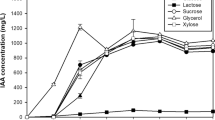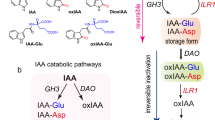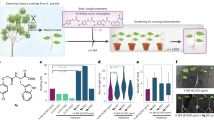Abstract
Desert candle (Euphorbia abyssinica J.F. Gmel.) (further referred to as EAG) is a succulent tree of dry deciduous and evergreen montane forest, woodland and shrub savanna. It occurs widely throughout dryland Africa, where it is appreciated as a live fence because it is easily propagated from untreated mature branch cuttings.Earlier we argued that the ability of large EAG branches to regenerate with ease in dry soil may be related to the natural plant growth regulator hormone indole acetic acid (IAA) contained in the latex of the plant. EAG latex samples from northern Ethiopia (n = 3) that were chemically analyzed contained on average 0.06 mg/l latex, as well as the IAA metabolites indole lactate (ILA) and indole ethanol (IEt). One sample also contained IAA conjugated to amino-acids and to glucose. Here we present a schematic overview of the potential pathways of IAA biosynthesis in EAG and suggest that auxin biosynthesis in EAG is tryptophane (Trp) dependent.
Similar content being viewed by others
Article PDF
Author information
Authors and Affiliations
Corresponding author
Rights and permissions
About this article
Cite this article
Aerts, R., Prinsen, E. & Muys, B. Potential pathways of indole acetic acid (IAA) biosynthesis in Euphorbia abyssinica. Nat Prec (2008). https://doi.org/10.1038/npre.2008.2212.1
Received:
Accepted:
Published:
DOI: https://doi.org/10.1038/npre.2008.2212.1



